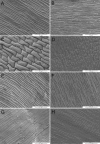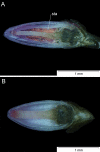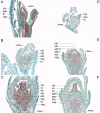'Who's who' in two different flower types of Calluna vulgaris (Ericaceae): morphological and molecular analyses of flower organ identity
- PMID: 20003430
- PMCID: PMC2803492
- DOI: 10.1186/1471-2229-9-148
'Who's who' in two different flower types of Calluna vulgaris (Ericaceae): morphological and molecular analyses of flower organ identity
Abstract
Background: The ornamental crop Calluna vulgaris is of increasing importance to the horticultural industry in the northern hemisphere due to a flower organ mutation: the flowers of the 'bud-flowering' phenotype remain closed i.e. as buds throughout the total flowering period and thereby maintain more colorful flowers for a longer period of time than the wild-type. This feature is accompanied and presumably caused by the complete lack of stamens. Descriptions of this botanical particularity are inconsistent and partially conflicting. In order to clarify basic questions of flower organ identity in general and stamen loss in detail, a study of the wild-type and the 'bud-flowering' flower type of C. vulgaris was initiated.
Results: Flowers were examined by macro- and microscopic techniques. Organ development was investigated comparatively in both the wild-type and the 'bud-flowering' type by histological analyses. Analysis of epidermal cell surface structure of vegetative tissues and perianth organs using scanning electron microscopy revealed that in wild-type flowers the outer whorls of colored organs may be identified as sepals, while the inner ones may be identified as petals. In the 'bud-flowering' type, two whorls of sepals are directly followed by the gynoecium. Both, petals and stamens, are completely missing in this flower type. The uppermost whorl of green leaves represents bracts in both flower types. In addition, two MADS-box genes (homologs of AP3/DEF and SEP1/2) were identified in C. vulgaris using RACE-PCR. Expression analysis by qRT-PCR was conducted for both genes in leaves, bracts, sepals and petals. These experiments revealed an expression pattern supporting the organ classification based on morphological characteristics.
Conclusions: Organ identity in both wild-type and 'bud-flowering' C. vulgaris was clarified using a combination of microscopic and molecular methods. Our results for bract, sepal and petal organ identity are supported by the 'ABCDE model'. However, loss of stamens in the 'bud-flowering' phenotype is an exceptional flower organ modification that cannot be explained by modified spatial expression of known organ identity genes.
Figures







Similar articles
-
"The usual suspects"- analysis of transcriptome sequences reveals deviating B gene activity in C. vulgaris bud bloomers.BMC Plant Biol. 2015 Jan 21;15:8. doi: 10.1186/s12870-014-0407-z. BMC Plant Biol. 2015. PMID: 25604890 Free PMC article.
-
A soybean MADS-box protein modulates floral organ numbers, petal identity and sterility.BMC Plant Biol. 2014 Apr 2;14:89. doi: 10.1186/1471-2229-14-89. BMC Plant Biol. 2014. PMID: 24693922 Free PMC article.
-
Heterotopic expression of class B floral homeotic genes supports a modified ABC model for tulip (Tulipa gesneriana).Plant Mol Biol. 2003 Jul;52(4):831-41. doi: 10.1023/a:1025070827979. Plant Mol Biol. 2003. PMID: 13677470
-
To B or Not to B a flower: the role of DEFICIENS and GLOBOSA orthologs in the evolution of the angiosperms.J Hered. 2005 May-Jun;96(3):225-40. doi: 10.1093/jhered/esi033. Epub 2005 Feb 4. J Hered. 2005. PMID: 15695551 Review.
-
'Organ'ising Floral Organ Development.Plants (Basel). 2024 Jun 8;13(12):1595. doi: 10.3390/plants13121595. Plants (Basel). 2024. PMID: 38931027 Free PMC article. Review.
Cited by
-
Tissue-specific genome instability in synthetic interspecific hybrids of Pennisetum purpureum (Napier grass) and Pennisetum glaucum (pearl millet) is caused by micronucleation.Chromosome Res. 2016 Sep;24(3):285-97. doi: 10.1007/s10577-016-9521-0. Epub 2016 Apr 12. Chromosome Res. 2016. PMID: 27072826
-
"The usual suspects"- analysis of transcriptome sequences reveals deviating B gene activity in C. vulgaris bud bloomers.BMC Plant Biol. 2015 Jan 21;15:8. doi: 10.1186/s12870-014-0407-z. BMC Plant Biol. 2015. PMID: 25604890 Free PMC article.
-
Evolution of petaloid sepals independent of shifts in B-class MADS box gene expression.Dev Genes Evol. 2012 Mar;222(1):19-28. doi: 10.1007/s00427-011-0385-1. Epub 2011 Dec 24. Dev Genes Evol. 2012. PMID: 22198545
-
AFLP-based genetic mapping of the "bud-flowering" trait in heather (Calluna vulgaris).BMC Genet. 2013 Aug 2;14:64. doi: 10.1186/1471-2156-14-64. BMC Genet. 2013. PMID: 23915059 Free PMC article.
References
-
- Stevens PF. Angiosperm Phylogeny Website. Version 8, June 2007 (and more or less continuously updated since) 2001. http://www.mobot.org/MOBOT/research/apweb
-
- Niehues R. In: Status quo und Perspektiven des deutschen Produktionsgartenbaus. 30. Dirksmeyer W, editor. vTI Agriculture and Forestry Research (Deutsche Bibliothek); 2009. Der Markt für Blumen und Pflanzen; pp. 81–98.
-
- Borchert T, Hohe A. Identification of molecular markers for the flower type in the ornamental crop Calluna vulgaris. Euphytica. pp. 203–213. - DOI
-
- Jansen J. Over eenige in ons Land aangetroffen Vormen van Calluna vulgaris. Nederl Kruid Arch. 1935;45:126–128.
-
- Heß D. Die Blüte. Einführung in Struktur und Funktion, Ökologie und Evolution der Blüten. 2. Auflage, Stuttgart, Ulmer. 1990. pp. 42–43.
Publication types
MeSH terms
Substances
LinkOut - more resources
Full Text Sources

